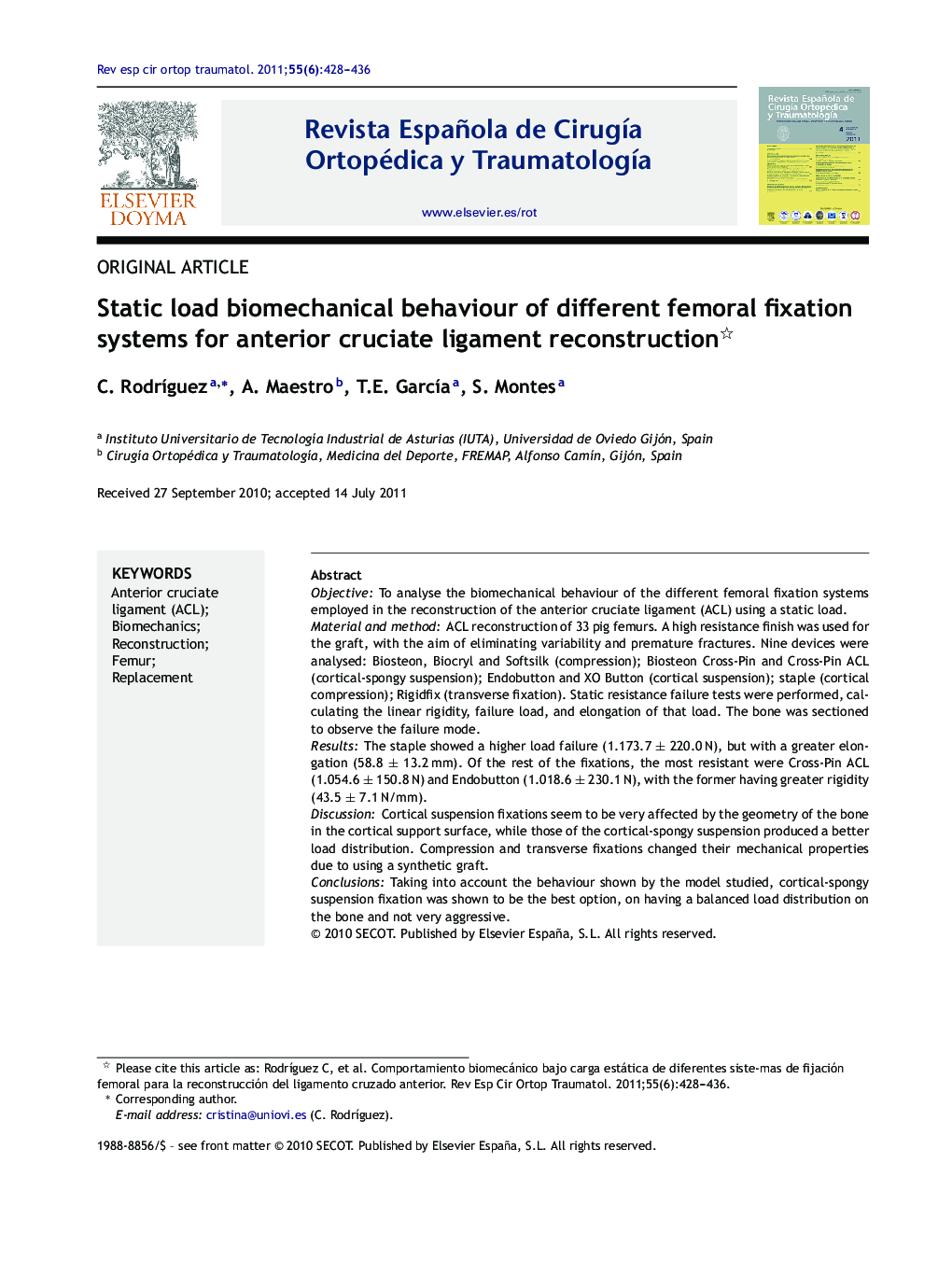| کد مقاله | کد نشریه | سال انتشار | مقاله انگلیسی | نسخه تمام متن |
|---|---|---|---|---|
| 4087213 | 1268023 | 2011 | 9 صفحه PDF | دانلود رایگان |

ObjectiveTo analyse the biomechanical behaviour of the different femoral fixation systems employed in the reconstruction of the anterior cruciate ligament (ACL) using a static load.Material and methodACL reconstruction of 33 pig femurs. A high resistance finish was used for the graft, with the aim of eliminating variability and premature fractures. Nine devices were analysed: Biosteon, Biocryl and Softsilk (compression); Biosteon Cross-Pin and Cross-Pin ACL (cortical-spongy suspension); Endobutton and XO Button (cortical suspension); staple (cortical compression); Rigidfix (transverse fixation). Static resistance failure tests were performed, calculating the linear rigidity, failure load, and elongation of that load. The bone was sectioned to observe the failure mode.ResultsThe staple showed a higher load failure (1.173.7 ± 220.0 N), but with a greater elongation (58.8 ± 13.2 mm). Of the rest of the fixations, the most resistant were Cross-Pin ACL (1.054.6 ± 150.8 N) and Endobutton (1.018.6 ± 230.1 N), with the former having greater rigidity (43.5 ± 7.1 N/mm).DiscussionCortical suspension fixations seem to be very affected by the geometry of the bone in the cortical support surface, while those of the cortical-spongy suspension produced a better load distribution. Compression and transverse fixations changed their mechanical properties due to using a synthetic graft.ConclusionsTaking into account the behaviour shown by the model studied, cortical-spongy suspension fixation was shown to be the best option, on having a balanced load distribution on the bone and not very aggressive.
ResumenObjetivoAnalizar el comportamiento biomecánico de diferentes sistemas de fijación femoral empleados en la reconstrucción del ligamento cruzado anterior (LCA) ante una sobrecarga estática.Material y métodoReconstrucción LCA en 33 fémures porcinos. Como injerto se utilizó un cabo de alta resistencia, a fin de eliminar la variabilidad y las roturas prematuras. Fueron analizados 9 dispositivos: Biosteon, Biocryl y Softsilk (compresión); Biosteon Cross-Pin y Cross-Pin ACL (suspensión cortico-esponjosa); Endobutton y XO Button (suspensión cortical); grapa (compresión cortical); Rigidfix (transfixión). Se realizaron ensayos estáticos de resistencia al fallo, calculando la rigidez lineal, la carga de fallo y la elongación en dicha carga. Se seccionó el hueso para observar el modo de fallo.ResultadosLa grapa mostró una carga de fallo mayor (1.173,7 ± 220,0 N), pero con una gran elongación (58,8 ± 13,2 mm). Del resto de fijaciones, las más resistentes fueron Cross-Pin ACL (1.054,6 ± 150,8 N) y Endobutton (1.018,6 ± 230,1 N), presentando la primera una mayor rigidez (43,5 ± 7,1 N/mm).DiscusiónLas fijaciones de suspensión cortical parecen muy influenciadas por la geometría del hueso en la superficie cortical de apoyo, mientras que las de suspensión cortico-esponjosa producen un mejor reparto de carga. Las fijaciones de compresión y de transfixión ven modificadas sus propiedades mecánicas por la utilización del injerto sintético.ConclusionesAtendiendo al comportamiento exhibido del modelo estudiado, las fijaciones de suspensión cortico-esponjosa se muestran como una opción muy buena, al realizar un reparto de cargas sobre el hueso equilibrado y poco agresivo.
Journal: Revista Española de Cirugía Ortopédica y Traumatología (English Edition) - Volume 55, Issue 6, November–December 2011, Pages 428–436